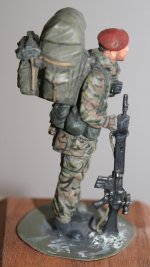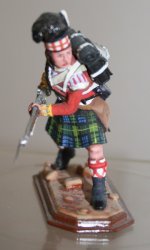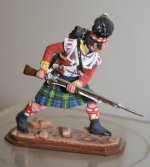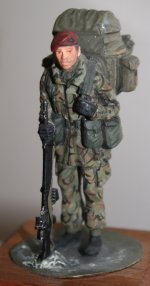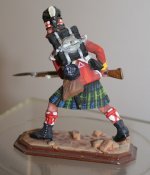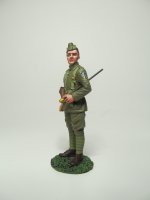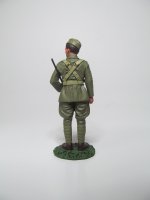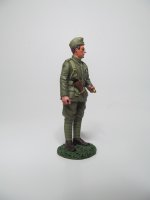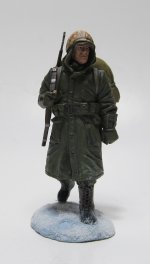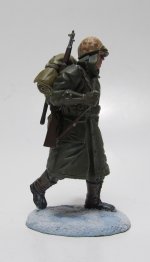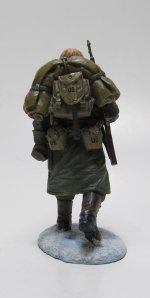Arnhemjim
Corporal
- Joined
- Aug 28, 2009
- Messages
- 403
Believe a healthy dose of honesty and candor are needed regarding the following subject. Hate the PC term “transparency”, sounds like “Cellophane Man” from the musical and movie “Chicago”. For those who may find it too cerebral, and/or inconsistent with the objective of “toy soldiers" being a hobby intended solely for joy and relaxation, my sincere apologies. Further for those who may feel a slight pinch in the size of the “boot” (intentional choice of words), am certain I will hear about it. Will also be curious as to whether this is the proverbial “third rail” in the hobby.
Personally, have frequently wondered what causes errors to occur in the finished production of military miniatures, aka “toy soldiers”. And even more to the point, to what extent are the errors inadvertent and unintentional, or intentional with full knowledge and malice of forethought? I think the predominate factor for the former, is ignorance of the subject matter (compounded by lack of motivation to learn), and for the latter it is time and cost. I think it is only in very isolated cases that artistic license, i.e. personal temperament, would motivate an intentional error, however am absolutely certain that it has occurred, as have personally witnessed same..
In an attempt to further analyze the issue, the reader might first consider the causes of ignorance of the subject matter;
• Lack of, or total non-existence, of any form of accurate reference material on the subject(s) of interest.
• Lack of knowledge of existing reference source materials, or even difficulty in obtaining same.
• Lack of linguistic skills requisite to recognize and/or convey available pertinent source materials.
• Lack of the requisite research skill sets to search for and fully exploit available reference materials.
• Misinterpretation of accurate available reference materials.
• Erroneous decision on conflicting sources of information (each claiming to be “impeccably accurate”, failing to pick the “right one”.
• Lack of mathematical skills requisite to interpret and/or translate available reference data.
• Conscious managerial decision to delegate research to individuals who supposedly possess the requisite skill sets, and do not.
• On review of a research report on a specific subject, making a judgement decision that the material is comprehensive and accurate.
Conversely there are equally identifiable causes which drive conscious intentional decisions to accept an error or errors;
• Budgetary limitations in one or more elements of the design, manufacturing and distribution processes.
• Overwhelming priority to beat the competition to market with new product or series.
• Production and delivery schedules which preclude identified errors being corrected.
• Magnitude of the error is not correctable within available time of business cycle.
• Materials/media, engineering, tooling and manufacturing processes which preclude accurate replication of size and scale at a competitive price.
• Complexity of actual figure, vehicle, or item precludes practical replication in miniature without compromise in accuracy.
• Selection of a primary construction material, because of availability and/or cost.
• Decision that level of accurate detail has to be limited in order that probable breakage in packaging and shipment are kept at an acceptable level of replacement costs.
• Decision to incorrectly modify configuration of previously issued model to save cost.
• Decision that a vast majority of buyers either would not have requisite knowledge to recognize the error, and/or in the eyes of the manufacturer, would not care.
Am not certain this covers all the causes of inaccuracies (apologies for overlap and redundancies), as there may well be an overlooked elephant in the room, which am certain will be immediately identified.
Arnhem Jim
Arizona Territories
Personally, have frequently wondered what causes errors to occur in the finished production of military miniatures, aka “toy soldiers”. And even more to the point, to what extent are the errors inadvertent and unintentional, or intentional with full knowledge and malice of forethought? I think the predominate factor for the former, is ignorance of the subject matter (compounded by lack of motivation to learn), and for the latter it is time and cost. I think it is only in very isolated cases that artistic license, i.e. personal temperament, would motivate an intentional error, however am absolutely certain that it has occurred, as have personally witnessed same..
In an attempt to further analyze the issue, the reader might first consider the causes of ignorance of the subject matter;
• Lack of, or total non-existence, of any form of accurate reference material on the subject(s) of interest.
• Lack of knowledge of existing reference source materials, or even difficulty in obtaining same.
• Lack of linguistic skills requisite to recognize and/or convey available pertinent source materials.
• Lack of the requisite research skill sets to search for and fully exploit available reference materials.
• Misinterpretation of accurate available reference materials.
• Erroneous decision on conflicting sources of information (each claiming to be “impeccably accurate”, failing to pick the “right one”.
• Lack of mathematical skills requisite to interpret and/or translate available reference data.
• Conscious managerial decision to delegate research to individuals who supposedly possess the requisite skill sets, and do not.
• On review of a research report on a specific subject, making a judgement decision that the material is comprehensive and accurate.
Conversely there are equally identifiable causes which drive conscious intentional decisions to accept an error or errors;
• Budgetary limitations in one or more elements of the design, manufacturing and distribution processes.
• Overwhelming priority to beat the competition to market with new product or series.
• Production and delivery schedules which preclude identified errors being corrected.
• Magnitude of the error is not correctable within available time of business cycle.
• Materials/media, engineering, tooling and manufacturing processes which preclude accurate replication of size and scale at a competitive price.
• Complexity of actual figure, vehicle, or item precludes practical replication in miniature without compromise in accuracy.
• Selection of a primary construction material, because of availability and/or cost.
• Decision that level of accurate detail has to be limited in order that probable breakage in packaging and shipment are kept at an acceptable level of replacement costs.
• Decision to incorrectly modify configuration of previously issued model to save cost.
• Decision that a vast majority of buyers either would not have requisite knowledge to recognize the error, and/or in the eyes of the manufacturer, would not care.
Am not certain this covers all the causes of inaccuracies (apologies for overlap and redundancies), as there may well be an overlooked elephant in the room, which am certain will be immediately identified.
Arnhem Jim
Arizona Territories
Last edited:


